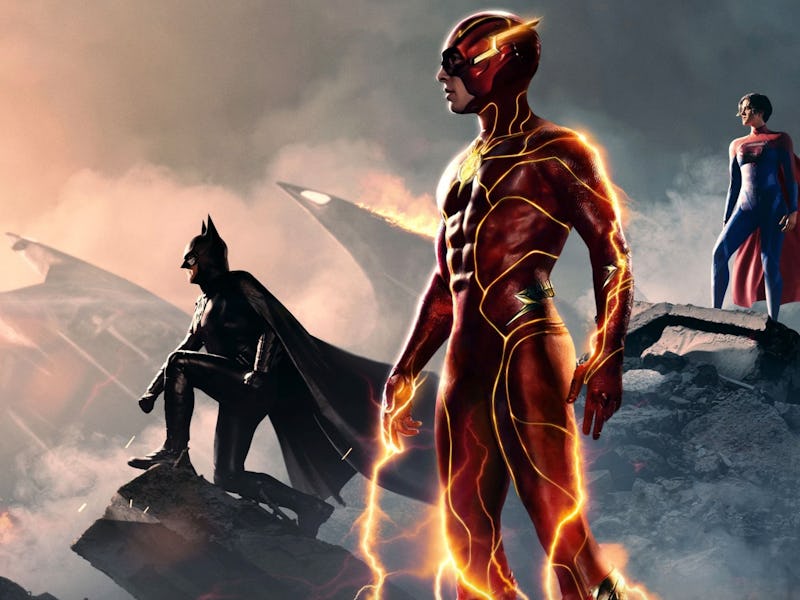The Flash Reveals Everything Wrong with Modern Superhero Movies — And Everything Right
There’s a difference between ambitious and sloppy.

The Flash is a big, ambitious movie. The latest addition to Hollywood’s growing list of multiversal blockbusters, it’s a film that introduces versions of DC characters that audiences have never seen before (Sasha Calle’s Supergirl) and gives actors like Michael Keaton and Michael Shannon a chance to reprise their past roles as Batman and General Zod, respectively. On top of that, The Flash also packs in not just one, but two variants of Barry Allen (Ezra Miller) himself, and confronts a portion of his tragic origin story head-on.
Certain aspects of the film — namely, its emphasis on Barry’s social isolation and nostalgic drive to change the past — feel like natural, organic topics for a Flash movie to explore. Other elements, like Michael Keaton’s return as Batman and the wave of computer-generated cameos that drowns The Flash’s story in its third act, reek of studio-mandated demands. The film’s apparent unevenness makes it easy to treat it with a lighter touch than one might otherwise.
But The Flash isn’t just a one-off miss for an otherwise reliable studio. It isn’t even a uniquely Warner Bros.-helmed comic book misfire. In many ways, The Flash is everything good and bad about the current era of big-screen superhero storytelling rolled into one bloated, sloppy piece of pop entertainment.
The Flash’s legacy DC cameos may be a lot of fun, but they don’t make much sense in the film itself.
Over the past 30 years or so, Hollywood’s treatment of the superhero genre has continually evolved. In the beginning, films like 1989’s Batman and 1978’s Superman treated their heroes and their stories with relative simplicity. They didn’t feel the need to comment on themselves. The same goes for films like 2002’s Spider-Man and, to an extent, 2008’s Iron Man. In the years since then, though, comic book movies have progressed past their meta, self-aware phase and dived headfirst into an era where the genre’s present can’t just comment on its past. The two must, instead, exist in the same space and interact with each other.
Hence: Hollywood’s current obsession with the multiverse, a device that allows storytellers to play around with established franchise canon in ways that might otherwise be impossible. As tired as the multiverse may now feel, it’s worth noting that there’s nothing inherently wrong with it as a narrative device, either. On paper, it’s the perfect vessel for superhero movies to — much like the comic books that have come before them — pursue bigger and more narratively complex stories. In the case of films like Everything Everywhere All At Once and Spider-Man: Across the Spider-Verse, they even allow their makers’ to ask and confront compelling questions regarding fate, purpose, and the toxic allure of existential nihilism.
More often than not, though, Hollywood and its studios have used the multiverse to fill their recent superhero films with nostalgia-bait cameos and Easter eggs. In the case of The Flash, while it’s refreshing to see a superhero’s first big-screen adventure try to tell such a massive, multidimensional story, the film ultimately becomes so obsessed with its cameo characters and ties to Warner Bros.’ past DC titles that it forgets to fully resolve or explore its hero’s story. The fact that the film skates past how Barry’s mom died, a massive element of the original Flashpoint comic that inspired its story, is an example of just how little time The Flash has for Barry Allen and his story.
At the end of the day, The Flash isn’t so much a movie about Barry Allen as it is a collage of various, disconnected crossover ideas.
The messiness of The Flash’s plot is reflected in its visual execution, a large part of which relies on CGI that not only looks unfinished but frequently turns the film’s characters into disconcerting rubber dolls. This is, perhaps, never more distressingly apparent than in The Flash’s opening setpiece, which lingers so long on shots of Play-Doh babies falling through the air in slow-motion that the film’s shoddy VFX almost begin to feel like a choice. According to The Flash director Andy Muschietti, they are, which is an even more depressing possibility to consider than if they were just unintentionally bad.
Together, The Flash’s untidy images and even more haphazard story make it feel like the inevitable end result of an era of superhero filmmaking that is undeniably more ambitious than all the others that have come before it, but which continues to be hampered by nostalgia-driven shortcuts and lackluster results. Only in 2023 could a movie like The Flash exist. It’s a Frankensteinian amalgamation of the best and worst parts of the modern blockbuster era, a giant, towering construct built on stick-thin legs that don’t have the strength to support its ideas or take it as far as it wants.